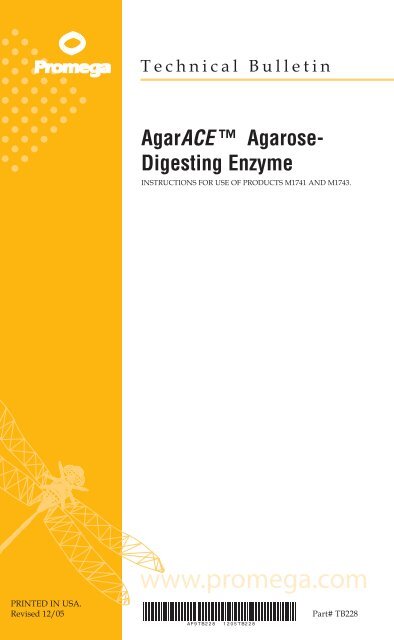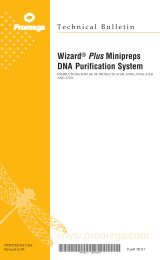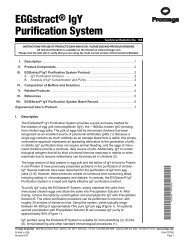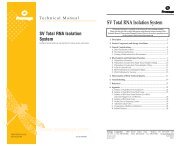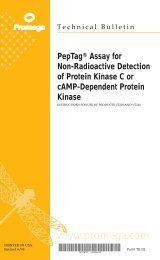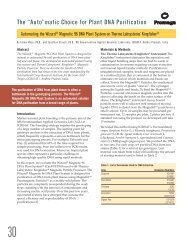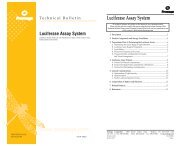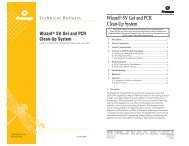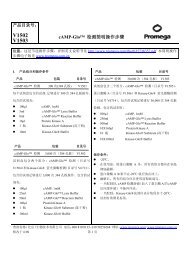AgarACE⢠Agarose-Digesting Enzyme
AgarACE⢠Agarose-Digesting Enzyme
AgarACE⢠Agarose-Digesting Enzyme
Create successful ePaper yourself
Turn your PDF publications into a flip-book with our unique Google optimized e-Paper software.
Technical Bulletin<br />
AgarACE <strong>Agarose</strong>-<br />
<strong>Digesting</strong> <strong>Enzyme</strong><br />
INSTRUCTIONS FOR USE OF PRODUCTS M1741 AND M1743.<br />
PRINTED IN USA.<br />
Revised 12/05<br />
AF9TB228<br />
1205TB228<br />
Part# TB228
AgarACE <strong>Agarose</strong>-<strong>Digesting</strong><br />
<strong>Enzyme</strong><br />
All technical literature is available on the Internet at www.promega.com/tbs/<br />
Please visit the web site to verify that you are using the most current version of this<br />
Technical Bulletin. Please contact Promega Technical Services if you have questions on use<br />
of this system. E-mail techserv@promega.com.<br />
I. Description..........................................................................................................2<br />
II. Product Components and Storage Conditions ............................................3<br />
III. General Considerations....................................................................................3<br />
A. Extended Digestions ............................................................................................5<br />
B. Variation in <strong>Agarose</strong> Type or Concentration...................................................5<br />
C. Variation in Buffer Type......................................................................................6<br />
D. Buffer Additives ...................................................................................................6<br />
IV. Basic AgarACE <strong>Enzyme</strong> Protocol................................................................7<br />
A. Digestion of <strong>Agarose</strong> with AgarACE <strong>Enzyme</strong>.............................................7<br />
B. Inactivation of AgarACE <strong>Enzyme</strong>..................................................................8<br />
V. Further Nucleic Acid Purification Protocols ................................................9<br />
A. Ethanol Precipitation of DNA and RNA ..........................................................9<br />
B. Water Soak Before <strong>Digesting</strong> Gel.....................................................................10<br />
VI. Application Compatibility Guide ................................................................10<br />
A. Ligation with T4 DNA Ligase .........................................................................11<br />
B. Cloning of Isolated Fragments .........................................................................11<br />
C. Transformation of Competent Cells ................................................................12<br />
D. Transformation of Bacterial Cells by Electroporation ..................................12<br />
E. Cloning into the pGEM ® -T Vector Systems ..................................................13<br />
F. 5´-End Labeling with T4 Polynucleotide Kinase ...........................................13<br />
G. Dephosphorylation with Alkaline Phosphatase, Calf Intestinal.................13<br />
H. Digestion with Restriction <strong>Enzyme</strong>s ...............................................................14<br />
I. Random Hexamer Labeling with Prime-a-Gene ® Labeling System...........15<br />
J. fmol ® DNA Cycle Sequencing System.............................................................15<br />
K. PCR from Isolated Fragment ............................................................................15<br />
VII. Troubleshooting...............................................................................................16<br />
VIII. Appendix ...........................................................................................................16<br />
A. Gel Preparation...................................................................................................16<br />
B. Composition of Buffers and Solutions ............................................................16<br />
C. Characteristics of AgarACE <strong>Enzyme</strong>...........................................................17<br />
D. Related Products.................................................................................................17<br />
E. Compatibility of AgarACE <strong>Enzyme</strong>-Isolated<br />
Nucleic Acid With Subsequent Applications.................................................19<br />
Promega Corporation · 2800 Woods Hollow Road · Madison, WI 53711-5399 USA<br />
Toll Free in USA 800-356-9526 · Phone 608-274-4330 · Fax 608-277-2516 · www.promega.com<br />
Printed in USA.<br />
Part# TB228<br />
Revised 12/05 Page 1
I. Description<br />
AgarACE <strong>Enzyme</strong> (a) is a unique agarose-digesting enzyme developed by<br />
Promega for simple and quantitative recovery of intact DNA or RNA from<br />
agarose gels. Isolated from a marine Flavobacterium, AgarACE <strong>Enzyme</strong><br />
completely digests agarose to ethanol-soluble oligosaccharides in 15 minutes.<br />
AgarACE <strong>Enzyme</strong> is sufficiently thermostable that low melting point (LMP)<br />
agarose melted at 65–75°C does not have to be equilibrated to the reaction<br />
temperature before hydrolysis. Simply place the tube containing the molten<br />
agarose at 42–47°C and add AgarACE <strong>Enzyme</strong>. With slight modifications to<br />
the protocol, AgarACE <strong>Enzyme</strong> can also effectively hydrolyze non-LMP<br />
agaroses, although the higher temperatures required to melt them may be<br />
deleterious to the DNA or RNA. Finally, AgarACE <strong>Enzyme</strong> does not require<br />
buffer exchange in order to exhibit high agarose hydrolytic activity; it works<br />
equally well in TAE or TBE buffers used in normal electrophoretic procedures.<br />
Promega has tested the performance of DNA isolated from agarose gels with<br />
AgarACE <strong>Enzyme</strong> in a number of downstream applications. Nucleic acids<br />
recovered using AgarACE <strong>Enzyme</strong> are ready for direct use in a number of<br />
procedures such as ligation, nick translation and sequencing. In other<br />
applications, an ethanol precipitation of the isolated nucleic acid is<br />
recommended before use. A guide to application compatibility is found in<br />
Section IV and Section VIII.E. The same information can be applied to other<br />
applications that are not specifically mentioned in this Technical Bulletin. Most<br />
interferences can be traced to gel running buffer components or hydrolyzed<br />
agarose, not to the AgarACE <strong>Enzyme</strong> directly. These interferences usually<br />
can be eliminated by the methods described.<br />
Selected Citations Using AgarACE <strong>Enzyme</strong>:<br />
• Blodgett, J.A.V., Zhang, J.K. and Metcalf, W.W. (2005) Molecular cloning, sequence<br />
analysis, and heterologous expression of the phosphinothricin tripeptide biosynthetic<br />
gene cluster from Streptomyces viridochromogenes DSM 40736. Antimicrob. Agents<br />
Chemother. 49, 230–40.<br />
AgarACE <strong>Enzyme</strong> was used to prepare DNA fragments during the creation of an<br />
S. viridochromogenes genomic library.<br />
• Odersky, A. et al. (2002) Repair of sequence-specific 125 I-induced double-strand breaks by<br />
nonhomologous DNA end joining in mammalian cell-free extracts. J. Biol. Chem. 277,<br />
11756–64.<br />
AgarACE was used to purify linear pUC19-MDR1 after a double-strand breakage<br />
assay with a triplex-forming oligonucleotide. The linear pUC19-MDR1 construct was<br />
purified from a 1.5% NuSieve ® agarose gel.<br />
For additional peer-reviewed articles citing use of this product, please visit:<br />
www.promega.com/citations<br />
Promega Corporation · 2800 Woods Hollow Road · Madison, WI 53711-5399 USA<br />
Toll Free in USA 800-356-9526 · Phone 608-274-4330 · Fax 608-277-2516 · www.promega.com<br />
Part# TB228<br />
Printed in USA.<br />
Page 2 Revised 12/05
II.<br />
Product Components and Storage Conditions<br />
Product Size Cat.#<br />
AgarACE <strong>Agarose</strong>-<strong>Digesting</strong> <strong>Enzyme</strong> 25u M1741<br />
500u M1743<br />
AgarACE <strong>Enzyme</strong> is supplied in a storage buffer containing 20mM Tris-HCl (pH 7.3<br />
at 23°C).<br />
Unit Definition: One unit of AgarACE <strong>Enzyme</strong> completely degrades 200µl<br />
(200mg) of molten 1% Cambrex SeaPlaque ® agarose in 1X TBE (pH 8.3) in<br />
15 minutes at 42–47°C as judged by release of reducing sugars.<br />
Storage Conditions: Store AgarACE <strong>Enzyme</strong> at –15 to –25°C. AgarACE<br />
<strong>Enzyme</strong> may be stored at 2–8°C for up to 3 weeks. AgarACE <strong>Enzyme</strong> is<br />
stable to at least 10 freeze-thaw cycles and is stable at room temperature<br />
(15–30°C) for at least 1 day.<br />
III.<br />
General Considerations<br />
Figure 1 depicts a basic protocol for the digestion of a 1% (w/v) Promega LMP,<br />
Preparative Grade <strong>Agarose</strong> gel in 1X TAE buffer using AgarACE <strong>Enzyme</strong>. A<br />
more detailed protocol is described in Section V. If you are using TAE and a 1%<br />
agarose gel prepared from preparative grade LMP agarose, this basic protocol<br />
should be sufficient for your needs. In general, using different buffers or<br />
agarose types will have very little effect on the number of units of AgarACE<br />
<strong>Enzyme</strong> required. However, the protocol must be modified when non-LMP<br />
agaroses are used (these changes are noted in the protocol in Section V). Using<br />
a different agarose percentage or digestion time effect how much AgarACE<br />
<strong>Enzyme</strong> is needed. The following subsections provide information on the<br />
amount of enzyme required under various digestion conditions.<br />
Promega Corporation · 2800 Woods Hollow Road · Madison, WI 53711-5399 USA<br />
Toll Free in USA 800-356-9526 · Phone 608-274-4330 · Fax 608-277-2516 · www.promega.com<br />
Printed in USA.<br />
Part# TB228<br />
Revised 12/05 Page 3
Prepare a 1% LMP agarose gel in TAE.<br />
Load samples and run in TAE.<br />
Wearing gloves, cut out the<br />
desired band from the gel.<br />
III.A. Extended Digestions<br />
!<br />
Table 1 indicates the amount of enzyme to use for different digestion times. If<br />
enzyme dilution is required, dilute the enzyme in deionized water just before use.<br />
Note: Do not store and reuse diluted enzyme.<br />
Table 1. Digestion Time Versus Units of <strong>Enzyme</strong>.<br />
Digestion Time<br />
Units of AgarACE <strong>Enzyme</strong><br />
15 minutes 1.0<br />
1 hour 0.25<br />
4 hours 0.1<br />
16 hours (overnight at 37°C)* 0.025<br />
Each reaction used 200µl (200mg) of molten 1% LMP agarose in 1X TBE or<br />
1X TAE at 42–47°C, unless otherwise noted. *Perform overnight digestions in<br />
a 37°C oven.<br />
Because of slow inactivation of AgarACE <strong>Enzyme</strong> at the optimal reaction<br />
temperature (42–47°C), a 37°C incubation is highly recommended for<br />
overnight digests. Perform long incubations in an oven rather than in a<br />
heating block, because a large fraction of the reaction volume can condense<br />
on the tube lid in a heating block overnight, concentrating the sample, which<br />
may lead to DNA nicking or other deleterious effects. In an oven,<br />
condensation is minimized. If you do not have access to a 37°C oven, perform<br />
extended digests in tubes that are at least 25% full.<br />
III.B. Variation in <strong>Agarose</strong> Type or Concentration<br />
Although AgarACE <strong>Enzyme</strong> has been tested with several agarose types, we<br />
recommend using Promega Low Melting Point (LMP), Preparative Grade<br />
<strong>Agarose</strong> [Cat.# V2831 for large fragments (>1,000bp) or Cat.# V3841 for small<br />
fragments (10–1,000bp)] or Cambrex SeaPlaque ® GTG ® or NuSieve ® GTG ®<br />
agarose, for most applications. AgarACE <strong>Enzyme</strong> appears to hydrolyze all<br />
agarose types at an equivalent rate and to an equivalent extent, provided the<br />
agarose is fully melted and has not regelled before the enzyme is added. This<br />
latter consideration is more serious in the case of non-LMP agarose because it<br />
tends to gel faster at the digestion temperature. Also, with non-LMP agarose,<br />
the high temperatures required to melt the agarose prior to digestion are likely<br />
to denature and/or degrade DNA and RNA. Thus, LMP agarose is<br />
recommended for most applications.<br />
It is important to use preparative grade agarose (see above for<br />
recommendations). Some analytical grade agarose has not been tested for trace<br />
nuclease activities and there can be batch-to-batch variability in the melting<br />
and gelling temperatures. More importantly, some analytical grade agaroses<br />
may contain impurities liberated by hydrolysis that can interfere with<br />
Promega Corporation · 2800 Woods Hollow Road · Madison, WI 53711-5399 USA<br />
Toll Free in USA 800-356-9526 · Phone 608-274-4330 · Fax 608-277-2516 · www.promega.com<br />
Printed in USA.<br />
Part# TB228<br />
Revised 12/05 Page 5
subsequent applications. These interferences might not be observed when the<br />
nucleic acid is isolated by other methods (e.g., electroelution) because the<br />
interfering agents may not be liberated from the gel under these conditions.<br />
AgarACE <strong>Enzyme</strong> activity is linear with respect to agarose concentration.<br />
One unit of AgarACE <strong>Enzyme</strong> will digest 200µl (200mg) of molten 1%<br />
agarose in 15 minutes, whereas 2 units of enzyme are required to digest an<br />
equivalent volume of 2% agarose in 15 minutes. At higher agarose<br />
concentrations, even more care must be taken to ensure complete melting and<br />
adequate mixing of the more viscous sample. In general, it is best and least<br />
expensive to use the lowest agarose concentration that will adequately resolve<br />
the bands of interest.<br />
III.C. Variation in Buffer Type<br />
AgarACE <strong>Enzyme</strong> performs equally well in TAE (pH 7.3, 7.8 or 8.3) and TBE<br />
(pH 8.3), and performs adequately in 20mM phosphate and MOPS buffers<br />
across the pH range of 6.5–8.5. However, the buffer selection may affect<br />
subsequent applications in which the isolated nucleic acid will be used<br />
(discussed in Section IV and VIII.E).<br />
III.D. Buffer Additives<br />
Various buffer additives have been tested for their effect on the performance of<br />
AgarACE <strong>Enzyme</strong>. The results are presented in Table 2.<br />
Table 2. Effects of Buffer Additives on AgarACE <strong>Enzyme</strong>.<br />
Additive<br />
ethidium bromide(0.5–5µg/ml)<br />
glycerol (0–50%)<br />
DTT (0–10mM)<br />
NaCl (0–200mM)<br />
NaCl (200–500mM)<br />
EDTA (0–10mM)<br />
SDS (0.3% w/v)<br />
formaldehyde<br />
Effect on AgarACE <strong>Enzyme</strong><br />
None<br />
None<br />
None<br />
None<br />
Causes variation in the digestion rate,<br />
not recommended<br />
None<br />
None<br />
Inactivates enzyme<br />
Inactivates enzyme<br />
Promega Corporation · 2800 Woods Hollow Road · Madison, WI 53711-5399 USA<br />
Toll Free in USA 800-356-9526 · Phone 608-274-4330 · Fax 608-277-2516 · www.promega.com<br />
Part# TB228<br />
Printed in USA.<br />
Page 6 Revised 12/05
IV.<br />
Basic AgarACE <strong>Enzyme</strong> Protocol<br />
This protocol can be used for the recovery of either DNA or RNA from agarose<br />
gels. Before pouring the gel, consult Section III.C and Section IV to select the<br />
appropriate running buffer and prepare any solutions required for subsequent<br />
applications. Refer to Section VIII.A for information about preparing agarose<br />
gels of accurate percentage.<br />
Materials to Be Supplied by the User<br />
(Solution compositions are provided in Section VIII.B.)<br />
• TAE or TBE buffer<br />
• <strong>Agarose</strong> [LMP, Preparative Grade (Cat.# V2831 or V3841) or<br />
Cambrex GTG ® LMP agarose]<br />
Note: Gelled agaraose consists of helical bundles of agarose fibers, and the<br />
fibers at the interior of the bundles cannot be attacked by the AgarACE<br />
<strong>Enzyme</strong>. If the agarose is not completely melted, the hydrolysis will also be<br />
incomplete, resulting in lower recoveries of polynucleotide and possible<br />
interference with downstream applications.<br />
IV.A. Digestion of <strong>Agarose</strong> with AgarACE <strong>Enzyme</strong><br />
1. Load and run the gel using your standard protocol. In general, TAE is the<br />
recommended running buffer, although TBE will work in some<br />
applications as noted in Section IV.<br />
2. Cut out the desired band from the gel with a clean, nuclease-free razor<br />
blade. Many razor blades have a protective oil coating that must be<br />
removed with ethanol. Use a long-wavelength UV lamp when visualizing<br />
DNA with intercalating dyes, such as ethidium bromide. Irradiate the gel<br />
for the absolute minimum time possible; preferably less than 30 seconds.<br />
Trim off any excess agarose.<br />
3. Using a nuclease-free spatula, transfer the gel slice to a previously weighed<br />
1.5ml microcentrifuge tube and determine the weight of the slice.<br />
4. Melt LMP agarose by incubating the gel slice at 65–75°C. Completely melt<br />
the agarose. A typical gel slice of 200µl (200mg) of 1% agarose will take<br />
approximately 10 minutes to melt in a 1.5ml microcentrifuge tube and 5<br />
minutes in a glass tube. If the gel slice is more than 300µl in volume, cut it<br />
into smaller pieces to aid melting.<br />
Unless the sample contains large (>10kb), shearable DNA, monitor melting<br />
by slowly pipetting the sample. If the agarose is completely melted, it<br />
should pipette freely and without lumps. For higher molecular weight<br />
DNA, tilt the tube and observe the angle at which the agarose begins to<br />
move down the side of the tube. Compare this to the angle for a control<br />
tube that contains agarose that is completely melted. Avoid agitating the<br />
sample. If agarose becomes lodged on the sides of the tube, centrifuge for<br />
1–2 seconds in a room temperature microcentrifuge.<br />
Promega Corporation · 2800 Woods Hollow Road · Madison, WI 53711-5399 USA<br />
Toll Free in USA 800-356-9526 · Phone 608-274-4330 · Fax 608-277-2516 · www.promega.com<br />
Printed in USA.<br />
Part# TB228<br />
Revised 12/05 Page 7
Note: The higher the temperature needed to melt non-LMP agarose may<br />
denature or degrade the DNA or RNA, so non-LMP-agarose is generally<br />
not recommended. If non-LMP agarose is used, melt the gel slice at the<br />
temperature recommended by the manufacturer (95–100°C). Equilibrate the<br />
melted gel slice to 70°C before adding the AgarACE <strong>Enzyme</strong> and<br />
incubating at 42–47°C (Step 5).<br />
5. Transfer the tube to a 42–47°C heating block and add the AgarACE<br />
<strong>Enzyme</strong> at a ratio of 1 unit per 200µl (200mg) of 1% gel (Section III.B).<br />
When using large volumes of agarose, pre-equilibrate the sample to<br />
42–47°C before adding the AgarACE <strong>Enzyme</strong>. If the volume is greater<br />
than 600µl (in a 1.5ml microcentrifuge tube), use multiple tubes. Mix the<br />
agarose gently by pipetting or mild agitation, taking care to avoid lodging<br />
material high up on the tube walls.<br />
6. Incubate the mixture for 15 minutes at 42–47°C (or longer if desired; refer<br />
to Section III.A for instructions regarding longer digestion times).<br />
7. At this point in the protocol, the nucleic acid can be used directly for a<br />
number of common procedures as noted in Section IV. Equilibrate the<br />
AgarACE <strong>Enzyme</strong>-treated sample to the optimal temperature for the<br />
desired application, or the high temperature of the sample may inactivate<br />
heat-sensitive enzymes (e.g., ligases). For applications where concentration<br />
or further purification of the nucleic acid is necessary, refer to Section VI<br />
for suggested protocols.<br />
IV.B. Inactivation of AgarACE <strong>Enzyme</strong><br />
In most cases, inactivation of AgarACE <strong>Enzyme</strong> is not necessary for use of<br />
the nucleic acid in subsequent applications. If you suspect that a particular<br />
application requires you to inactivate AgarACE <strong>Enzyme</strong>, it can be<br />
inactivated by either heat or addition of SDS.<br />
Heat Inactivation<br />
1. Place the tube containing the hydrolyzed agarose in a water bath at<br />
65–75°C.<br />
!<br />
2. After 15 minutes, remove the tube and equilibrate it at the temperature<br />
appropriate for the subsequent manipulation.<br />
Do not exceed 75°C, or DNA may be denatured and RNA degraded.<br />
SDS Inactivation<br />
Add 1/10 volume of 10% SDS to the tube containing the hydrolyzed agarose<br />
and mix gently. For many subsequent applications, the SDS must be removed<br />
by phenol:chloroform extraction and ethanol precipitation. Therefore, this<br />
method is not generally recommended.<br />
Promega Corporation · 2800 Woods Hollow Road · Madison, WI 53711-5399 USA<br />
Toll Free in USA 800-356-9526 · Phone 608-274-4330 · Fax 608-277-2516 · www.promega.com<br />
Part# TB228<br />
Printed in USA.<br />
Page 8 Revised 12/05
V. Further Nucleic Acid Purification Protocols<br />
Nucleic acid released from agarose with AgarACE <strong>Enzyme</strong> can be used<br />
directly in a number of applications. For some applications, however, you may<br />
need to remove interfering substances either before or after AgarACE<br />
<strong>Enzyme</strong> digestion. The pH, the borate ions or the EDTA in the gel buffer are<br />
the most likely components to interfere with downstream applications. For<br />
certain applications, you may need to concentrate the nucleic acid before use. In<br />
general, we have found that these requirements can be met by ethanol<br />
precipitation after digestion, or by soaking the gel briefly in water before<br />
digestion, depending on the application. Refer to Section IV for guidelines on<br />
specific applications. Phenol:chloroform extraction before ethanol precipitation<br />
can also be performed; however, very few applications require it.<br />
V.A. Ethanol Precipitation of DNA and RNA<br />
Using this protocol, the final yields are not dependent on size when the nucleic<br />
acids are between 200–4,000bp. Good yields of DNA and RNA have been<br />
obtained with 100ng total nucleic acid (>90% using NaOAc and >60% using<br />
NH 4 OAc), and excellent recoveries are possible with 500ng total nucleic acid<br />
(>95% yield using either NaOAc or NH 4 OAc). Ethanol does precipitate some<br />
of the AgarACE along with the DNA or RNA. We have not observed cases<br />
where coprecipitated AgarACE interferes with downstream applications, but<br />
if this is undesirable for a new application, perform a standard phenol:<br />
chloroform extraction before ethanol precipitation.<br />
Materials to Be Supplied by the User<br />
(Solution compositions are provided in Section VIII.B.)<br />
• 3M NaOAc (pH 5.2) or 7.5M NH 4 OAc (optional)<br />
• ethanol (95% and 70%)<br />
1. Hydrolyze the agarose completely as described in the standard procedure<br />
(Section V.A).<br />
2. For sodium acetate precipitation, add 0.1 volume of 3M NaOAc (pH 5.2),<br />
mix, then add 2 volumes of room temperature 95% ethanol (2 times the<br />
volume after NaOAc addition). For ammonium acetate precipitation, add<br />
0.5 volume of 7.5M NH 4 OAc, mix, then add 2.5 volumes of room<br />
temperature 95% ethanol (2.5 times the volume after NH 4 OAc addition).<br />
Perform ethanol precipitations at room temperature with room<br />
temperature ethanol to avoid precipitating traces of oligosaccharides.<br />
3. Allow the mixture to stand 1–2 hours (2 hours for small amounts of DNA<br />
in NH 4 OAc) at room temperature, then centrifuge for 15 minutes in a<br />
microcentrifuge at maximum speed at room temperature.<br />
4. Immediately decant the supernatant, orienting the tube so that the pellet is<br />
on the upper side of the tube. Respin the tube for 1–2 seconds in a<br />
Promega Corporation · 2800 Woods Hollow Road · Madison, WI 53711-5399 USA<br />
Toll Free in USA 800-356-9526 · Phone 608-274-4330 · Fax 608-277-2516 · www.promega.com<br />
Printed in USA.<br />
Part# TB228<br />
Revised 12/05 Page 9
microcentrifuge to bring down residual supernatant. Remove the<br />
remaining supernatant by careful pipetting.<br />
5. Wash the pellet by adding 200–500µl of cold (
This section is designed to help the researcher determine what measures should<br />
be taken before running the gel to ensure the best performance of nucleic acids<br />
isolated using AgarACE <strong>Enzyme</strong> in subsequent applications. In most cases,<br />
we have tested for performance with Promega products and not for<br />
compatibility with similar commercially available products. In addition, all of<br />
our application compatibility test data have been generated using Promega<br />
Low Melting Point (LMP), Preparative Grade <strong>Agarose</strong> (Cat.# V2831 for large<br />
fragments or Cat.# V3841 for small fragments). If you obtain information<br />
regarding the compatibility or incompatibility of AgarACE <strong>Enzyme</strong>-isolated<br />
nucleic acids with specific kits or agaroses, please feel free to contact our<br />
Technical Services Department (1-800-356-9526) so that we can include the<br />
information in future revisions of this Technical Bulletin. A summary of the<br />
application compatibility information is presented in Section VIII.E.<br />
VI.A. Ligation with T4 DNA Ligase<br />
DNA isolated from agarose using AgarACE <strong>Enzyme</strong> can be used directly in<br />
ligations with T4 DNA Ligase (Cat.# M1801), if the DNA concentration is within<br />
the range normally used by the researcher. If it is necessary to concentrate the<br />
DNA, perform an ethanol precipitation (see Section VI.A). Cool the mixture to at<br />
least room temperature before adding the ligase buffer or the ligase enzyme to<br />
avoid thermal inactivation. To minimize problems arising from endonucleases<br />
present in the running buffer or introduced during handling of the gel, use<br />
short-term ligations (≤6 hours) rather than overnight ligations.<br />
Note: Although ligations work well regardless of the running buffer used,<br />
transformation efficiencies after ligation vary considerably depending on the<br />
type of buffer used and the amount added to the ligation. Refer to Section IV.C<br />
for more information.<br />
VI.B. Cloning of Isolated Fragments<br />
DNA isolated from agarose using AgarACE <strong>Enzyme</strong> can be used in standard<br />
cloning procedures, if the DNA concentration is within the range normally<br />
used by the researcher. Although DNA isolated from agarose using<br />
AgarACE <strong>Enzyme</strong> works well in the ligation step of cloning, the efficiency of<br />
the transformation step is very sensitive to the alkaline pH of the gel running<br />
buffers. The buffer used in the ligation step [30mM Tris-HCl (pH 7.8), 10mM<br />
MgCl 2 , 10mM DTT, 1mM ATP (final concentration)] moderates this effect<br />
significantly. Since the buffer strength in TBE is much higher than TAE,<br />
greater negative effects on transformation are seen with TBE buffer than TAE.<br />
When using TAE as the gel running buffer, the ligation reaction should be set<br />
up so that ≤5µl is used per 100µl of competent cells in the transformation step<br />
(see Section IV.A for general considerations). If it is necessary to concentrate<br />
the DNA to meet this requirement, perform an ethanol precipitation (see<br />
Section VI.A) after isolating it from the agarose and before adding it to the<br />
ligation reaction.<br />
Promega Corporation · 2800 Woods Hollow Road · Madison, WI 53711-5399 USA<br />
Toll Free in USA 800-356-9526 · Phone 608-274-4330 · Fax 608-277-2516 · www.promega.com<br />
Printed in USA.<br />
Part# TB228<br />
Revised 12/05 Page 11
When using TBE buffer, we recommend either running the gel in 0.5X TBE or<br />
soaking the gel containing the DNA in water (see Section VI.B) prior to<br />
digestion with AgarACE <strong>Enzyme</strong>. Alternatively, ethanol precipitate the<br />
DNA after isolation from the agarose (see Section VI.A). The ligation reaction<br />
should be set up so that ≤8µl is used per 100µl of competent cells in the<br />
transformation step (see Section IV.A for general considerations). With any of<br />
these treatments, the maximum number of colonies will be approximately 40%<br />
of that observed when transforming with DNA in water. If absolutely<br />
necessary, it is possible to ligate isolated DNA and transform cells as described<br />
for TAE buffer, but the absolute maximum volume of the ligation reaction that<br />
can be added to the competent cells is very low (≤3µl per 100µl of competent<br />
cells), and the transformation efficiency is highly variable.<br />
VI.C. Transformation of Competent Cells<br />
DNA isolated from agarose using AgarACE <strong>Enzyme</strong> cannot be used directly<br />
for transformation of competent cells. As noted in Section IV.B, the pH of the<br />
gel running buffers commonly used are too alkaline to obtain good<br />
transformation efficiencies, but ligase buffer significantly moderates the effects<br />
of the running buffer. For this reason, we recommend adding ligase buffer<br />
without ligase to the AgarACE <strong>Enzyme</strong>-isolated DNA (a “pseudoligation”<br />
reaction) before transforming competent cells.<br />
When using DNA isolated from a gel cast and run in TAE, prepare a<br />
“pseudoligation” reaction by adding 1/10 volume of 10X ligase buffer [300mM<br />
Tris-HCl (pH 7.8), 100mM MgCl 2 , 100mM DTT, 10mM ATP] to the DNA. The<br />
“pseudoligation” reaction should be set up so that ≤5µl is used per 100µl of<br />
competent cells in the transformation step (see Section IV.A). If you need to<br />
concentrate the DNA, perform an ethanol precipitation (see Section VI.A) after<br />
isolating the DNA from the agarose and before adding it to the<br />
“pseudoligation” reaction.<br />
When using TBE buffer, we recommend either running the gel in 0.5X TBE or<br />
soaking the gel containing the DNA in water (see Section VI.B) before<br />
digestion with AgarACE <strong>Enzyme</strong>. Alternatively, ethanol precipitate the<br />
DNA after isolation from agarose (see Section VI.A). The “pseudoligation”<br />
reaction should be set up so that ≤8µl is used per 100µl of competent cells in<br />
the transformation step. With any of these treatments, the maximum number<br />
of colonies will be approximately 40% of that observed when transforming<br />
with DNA in water. If necessary, you can transform cells as described above<br />
for TAE buffer, but the absolute maximum volume of the “pseudoligation”<br />
reaction that can be added to the competent cells is low (≤3µl per 100µl of<br />
competent cells), and the transformation efficiency is highly variable.<br />
VI.D. Transformation of Bacterial Cells by Electroporation<br />
DNA isolated from agarose using AgarACE <strong>Enzyme</strong> cannot be used directly<br />
for transformation by electroporation because the ionic strength of the buffers<br />
and the hydrolyzed agarose cause electrical arcing in the electroporation<br />
Promega Corporation · 2800 Woods Hollow Road · Madison, WI 53711-5399 USA<br />
Toll Free in USA 800-356-9526 · Phone 608-274-4330 · Fax 608-277-2516 · www.promega.com<br />
Part# TB228<br />
Printed in USA.<br />
Page 12 Revised 12/05
cuvette. Before using the DNA for electroporation, ethanol precipitate it using<br />
sodium acetate and wash the DNA pellet at least once with cold (
If TBE is used as the running buffer, CIAP will be completely inhibited by the<br />
borate ions, which act as competitive inhibitors of the enzyme. If the gel must<br />
be run in TBE, ethanol precipitate the nucleic acid before treating with CIAP<br />
(Section VI.A). Alternatively, the nucleic acid may be dephosphorylated before<br />
running the gel.<br />
VI.H. Digestion with Restriction <strong>Enzyme</strong>s<br />
In general, more units of restriction enzyme are required to cut DNA isolated<br />
from agarose with AgarACE <strong>Enzyme</strong> than for DNA in water. The<br />
magnitude of this effect differs with each enzyme and appears to be a<br />
combination of the effects of the hydrolyzed agarose, the buffer and, in some<br />
instances, the AgarACE <strong>Enzyme</strong> itself. Since in many cases the majority of<br />
the inhibition cannot be traced specifically to AgarACE <strong>Enzyme</strong>, we believe<br />
that this problem has existed for some time with other agarases as well. In<br />
some cases, such as digests with Pst I, you may need to purify further the<br />
DNA using the Wizard ® PCR Preps DNA Purification System (Cat.# A7170) to<br />
eliminate this problem. When purifying the DNA with Wizard ® PCR Preps,<br />
you need to use TAE as the running buffer because TBE buffer is not<br />
compatible with this purification system. To avoid the potential difficulties<br />
associated with restriction of agarase-isolated DNA, digest the DNA before<br />
electrophoresis. Table 3 lists the effects of agarose and AgarACE <strong>Enzyme</strong><br />
treatment on the activity of various restriction enzymes.<br />
Table 3. Effect of AgarACE <strong>Enzyme</strong> Digestion on Restriction <strong>Enzyme</strong> Activity.<br />
<strong>Enzyme</strong><br />
*Units Required if<br />
Isolated from<br />
1X TBE Gel**<br />
*Units Required if<br />
Isolated from<br />
1X TAE Gel<br />
Notes<br />
Acc I 3.5X 7X Use Wizard ® PCR Preps<br />
Apa I 3X 3X<br />
Bam HI 4X 4X<br />
EcoR I 6X 6X Use Wizard ® PCR Preps<br />
Hind III 8.5X 8.5X Use Wizard ® PCR Preps<br />
Kpn I 4X 4X<br />
Not I 3.5X 2X<br />
Pst I 7X 17X Use Wizard ® PCR Preps<br />
Sac I 1X 1.5X<br />
Sal I 1.5X 2X<br />
Sph I 1X 1X<br />
*The amount of restriction enzyme required (X-fold) to digest the DNA relative to a<br />
control digestion containing DNA in water. The DNA was isolated from Promega LMP,<br />
Preparative Grade agarose. Other agaroses may give different results.**The use of TBE<br />
buffer is not recommended with the Wizard ® PCR Preps DNA Purification System.<br />
Promega Corporation · 2800 Woods Hollow Road · Madison, WI 53711-5399 USA<br />
Toll Free in USA 800-356-9526 · Phone 608-274-4330 · Fax 608-277-2516 · www.promega.com<br />
Part# TB228<br />
Printed in USA.<br />
Page 14 Revised 12/05
VI.I. Random Hexamer Labeling with Prime-a-Gene ® Labeling System<br />
DNA isolated from agarose using AgarACE <strong>Enzyme</strong> can be used directly in<br />
random hexamer labeling reactions using the Prime-a-Gene ® Labeling System<br />
(Cat.# U1100), if the DNA concentration is within the range normally used by<br />
the researcher. If you need to concentrate the DNA, perform an ethanol<br />
precipitation (see Section VI.A).<br />
Note: Cool the mixture to at least room temperature before adding the<br />
components of the Prime-a-Gene ® Labeling System to avoid thermal<br />
inactivation.<br />
VI.J. fmol ® DNA Cycle Sequencing System<br />
DNA isolated from agarose using AgarACE <strong>Enzyme</strong> can be used directly in<br />
the fmol ® DNA Cycle Sequencing System (Cat.# Q4100), if the DNA<br />
concentration is within the range normally used by the researcher. If you need<br />
to concentrate the DNA, perform an ethanol precipitation (see Section VI.A; be<br />
certain that the DNA is completely resolubilized). TAE is the recommended<br />
running buffer. In some cases, “hard stops” have been observed at various<br />
locations when the DNA was not ethanol precipitated. In such instances,<br />
ethanol precipitation of the test DNA eliminated the problem. If TAE is used<br />
as the running buffer, the pH should be 8.3. A recipe is provided in Section<br />
VIII.B. If TBE buffer is used, an ethanol precipitation must be performed<br />
because TBE inhibits the sequencing reactions.<br />
VI.K. PCR from Isolated Fragment<br />
DNA isolated from agarose using AgarACE <strong>Enzyme</strong> can be used directly in<br />
PCR (b) , provided the DNA concentration is within the ranges normally used by<br />
the researcher. If it is necessary to concentrate the DNA, perform an ethanol<br />
precipitation (see Section VI.A). TAE is highly recommended as the running<br />
buffer. When TAE is used, the yield of amplified product is similar to that<br />
obtained from control DNA in water alone. When TBE is used, the yield of<br />
amplification product can decrease by two- to threefold relative to a control<br />
DNA in water. This low yield does not appear to be remedied by increasing<br />
the number of thermal cycles. However, ethanol precipitation (see Section<br />
VI.A) of the template DNA does eliminate the problem.<br />
Promega Corporation · 2800 Woods Hollow Road · Madison, WI 53711-5399 USA<br />
Toll Free in USA 800-356-9526 · Phone 608-274-4330 · Fax 608-277-2516 · www.promega.com<br />
Printed in USA.<br />
Part# TB228<br />
Revised 12/05 Page 15
VII. Troubleshooting<br />
Symptom<br />
Large quantities of white or translucent<br />
precipitate in tube when ethanol<br />
precipitated; pellet resuspends poorly.<br />
Causes and Comments<br />
Incomplete digestion of agarose before<br />
precipitation due to loss of enzyme activity.<br />
Resuspend sample, remelt residual agarose<br />
and retreat with AgarACE <strong>Enzyme</strong>.<br />
Incomplete digestion of agarose because of<br />
high agarose concentration. Resuspend<br />
sample, remelt residual agarose and retreat<br />
with AgarACE <strong>Enzyme</strong>.<br />
Incomplete digestion of agarose because of<br />
buffer incompatibility. Repeat using a<br />
different buffer or longer incubation.<br />
VIII. Appendix<br />
VIII.A. Gel Preparation<br />
To accurately determine how much AgarACE <strong>Enzyme</strong> is needed to digest<br />
the gel, you must know the exact agarose percentage in the gel. Carefully<br />
weigh the agarose into the buffer solution. Also, when melting agarose, a<br />
significant amount of water can evaporate. If this volume is not replaced, the<br />
agarose gel will be of a higher percentage than expected, and more<br />
AgarACE <strong>Enzyme</strong> will be required to obtain complete digestion. This effect<br />
tends to be more pronounced when a microwave oven is used to melt the<br />
agarose. We recommend weighing the container of agarose/buffer both before<br />
and after melting the agarose. If the volume has been reduced by evaporation,<br />
add deionized water to the molten agarose until the solution has been restored<br />
to its original weight. Alternatively, use a 10–20% excess of AgarACE<br />
<strong>Enzyme</strong> to compensate for potential differences in agarose concentration.<br />
VIII.B. Composition of Buffers and Solutions<br />
7.5M NH 4 OAc (100ml)<br />
57.81g ammonium acetate<br />
Dissolve the ammonium acetate in<br />
100ml water (final volume). Sterilize by<br />
filtration (0.45µm filter).<br />
3M NaOAc (pH 5.2; 100ml)<br />
24.61g sodium acetate<br />
Dissolve the sodium acetate in water,<br />
adjust the pH to 5.2 with acetic acid<br />
and bring the final volume to 100ml<br />
with water. Sterilize by filtration<br />
(0.45µm filter).<br />
1X TAE buffer<br />
40mM Tris acetate<br />
(with respect to Tris)<br />
1mM EDTA<br />
Adjust the pH to 8.3 with glacial acetic<br />
acid.<br />
1X TBE buffer<br />
89mM Tris-borate (pH 8.3)<br />
2mM EDTA<br />
Promega Corporation · 2800 Woods Hollow Road · Madison, WI 53711-5399 USA<br />
Toll Free in USA 800-356-9526 · Phone 608-274-4330 · Fax 608-277-2516 · www.promega.com<br />
Part# TB228<br />
Printed in USA.<br />
Page 16 Revised 12/05
VIII.C. Characteristics of AgarACE <strong>Enzyme</strong><br />
Molecular Weight: 42kDa.<br />
Usable pH Range: 6.5–8.5; less than 20% activity variation over this range.<br />
Optimal Temperature Range: 42–47°C.<br />
Method of Inactivation: >65°C for 15 minutes.<br />
Stability: The expiration date is indicated on the product label for product<br />
stored at –15 to –25°C. The enzyme is stable for 3 weeks at 4–8°C and >1 day<br />
at room temperature. Stable to at least 10 freeze-thaw cycles.<br />
VIII.D. Related Products<br />
<strong>Agarose</strong><br />
Product Size Cat. #<br />
<strong>Agarose</strong>, Low Melting Point, Preparative Grade<br />
for Large Fragments (>1,000bp) 25g V2831<br />
<strong>Agarose</strong>, Low Melting Point, Preparative Grade<br />
for Small Fragments (10–1,000bp) 25g V3841<br />
Buffers and Reagents<br />
Product Size Cat. #<br />
TAE Buffer, 10X 1,000ml V4271<br />
TAE Buffer, 40X 1,000ml V4281<br />
TBE Buffer, 10X 1,000ml V4251<br />
SDS Solution (10%w/v) 100ml V6551<br />
500ml V6553<br />
Nuclease-Free Water* 50ml P1193<br />
*For Laboratory Use.<br />
Competent E. coli Strains<br />
Product Size Cat.#<br />
HB101 Competent Cells >10 8 cfu/µg 1ml (5 × 200µl) L2011<br />
HB101 Competent Cells >10 7 cfu/µg 1ml (5 × 200µl) L1011<br />
JM109 Competent Cells >10 8 cfu/µg* 1ml (5 × 200µl) L2001<br />
JM109 Competent Cells >10 7 cfu/µg 1ml (5 × 200µl) L1001<br />
*For Laboratory Use.<br />
Promega Corporation · 2800 Woods Hollow Road · Madison, WI 53711-5399 USA<br />
Toll Free in USA 800-356-9526 · Phone 608-274-4330 · Fax 608-277-2516 · www.promega.com<br />
Printed in USA.<br />
Part# TB228<br />
Revised 12/05 Page 17
<strong>Enzyme</strong>s<br />
Product Size Conc. (u/µl) Cat.#<br />
Alkaline Phosphatase, Calf Intestinal 1,000u 1 M1821<br />
T4 DNA Ligase 100u (Weiss) 1–3 M1801<br />
500u (Weiss) 1–3 M1804<br />
500u (Weiss) 10–20 M1794<br />
T4 Polynucleotide Kinase 100u 5–10 M4101<br />
1,000u 5–10 M4103<br />
*For Laboratory Use.<br />
Miscellaneous<br />
Product Size Cat. #<br />
DNA 5´ End-Labeling System 10 reactions U2010<br />
fmol ® DNA Cycle Sequencing System 100 reactions Q4100<br />
Prime-a-Gene ® Labeling System 30 reactions U1100<br />
*For Laboratory Use.<br />
pGEM ® T-Vector Systems<br />
Product Size Cat.#<br />
pGEM ® -T Vector System I 20 reactions A3600<br />
pGEM ® -T Vector System II 20 reactions A3610<br />
pGEM ® -T Easy Vector System I 20 reactions A1360<br />
pGEM ® -T Easy Vector System II 20 reactions A1380<br />
*For Laboratory Use.<br />
DNA Purification System<br />
Product Size Cat.#<br />
Wizard ® PCR Preps DNA Purification System 50 preps* A7170<br />
Wizard ® SV Gel and PCR Clean-Up System 50 preps* A9281<br />
Wizard ® MagneSil ® PCR Clean-Up System 4 × 96 preps* A1930<br />
Wizard ® SV 96 PCR Clean-Up System 1 × 96 preps* A9340<br />
Wizard ® DNA Clean-Up System 100 preps* A7280<br />
For Laboratory Use. *Additional sizes available.<br />
Promega Corporation · 2800 Woods Hollow Road · Madison, WI 53711-5399 USA<br />
Toll Free in USA 800-356-9526 · Phone 608-274-4330 · Fax 608-277-2516 · www.promega.com<br />
Part# TB228<br />
Printed in USA.<br />
Page 18 Revised 12/05
VII.E. Compatibility of AgarACE ® <strong>Enzyme</strong>-Isolated Nucleic Acid with Downstream<br />
Applications<br />
Application (running<br />
buffer)<br />
Ligation<br />
TAE<br />
TBE<br />
Cloning DNA fragment<br />
TAE<br />
TBE<br />
Transformation of E. coli<br />
TAE<br />
TBE<br />
Electroporation of E. coli<br />
TAE<br />
TBE<br />
pGEM ® -T Vector Cloning<br />
TAE<br />
TBE<br />
Labeling with PNK<br />
TAE<br />
TBE<br />
Dephosphorylation (AP)<br />
TAE<br />
TBE<br />
Restriction Digestions<br />
TAE<br />
TBE<br />
Prime-a-Gene ® Labeling<br />
TAE<br />
TBE<br />
fmol ® DNA sequencing<br />
TAE<br />
TBE<br />
PCR<br />
TAE<br />
TBE<br />
Directly Usable in<br />
Application?<br />
Yes<br />
Yes<br />
Yes<br />
Yes<br />
No<br />
No<br />
No<br />
No<br />
Yes<br />
Yes<br />
Yes for TAE and<br />
TBE, but lower<br />
labeling efficiency<br />
Yes<br />
No<br />
Yes for both, but<br />
more enzyme will<br />
be needed.<br />
Yes<br />
Yes<br />
Yes<br />
No<br />
Yes<br />
Yes, but 40–60%<br />
yield<br />
Required<br />
Pretreatment<br />
None<br />
None<br />
None<br />
None<br />
Add ligase<br />
buffer to<br />
samples.<br />
Ethanol<br />
precipitation<br />
None for TAE<br />
gels. Soak TBE<br />
gels in water.<br />
Add 2X kinase<br />
(optional)<br />
None<br />
Ethanol<br />
precipitation<br />
Pretreatment<br />
will depend<br />
on enzyme<br />
used.<br />
None<br />
None<br />
Ethanol<br />
precipitation<br />
None<br />
Ethanol<br />
precipitation<br />
Comments<br />
TBE lowers<br />
transformation efficiency.<br />
See Sections IV.A and B.<br />
TBE can greatly lower<br />
transformation efficiency.<br />
See Section IV.B.<br />
For TBE, DNA volume is<br />
important. See Section<br />
IV.C.<br />
Slightly fewer colonies<br />
obtained. See Section<br />
IV.D.<br />
The number of colonies is<br />
variable. See Section IV.E.<br />
Soaking the gel in water<br />
can improve labeling See<br />
Section IV.F.<br />
Borate ions inhibit CIAP.<br />
See Section IV.G.<br />
Important! Varies for<br />
enzyme used in<br />
restriction digest. See<br />
Section IV.H.<br />
See Section IV.I.<br />
Ethanol precipitation<br />
before sequencing is<br />
useful for eliminating<br />
“hard stops.” Section IV.J.<br />
See Section IV.L<br />
Promega Corporation · 2800 Woods Hollow Road · Madison, WI 53711-5399 USA<br />
Toll Free in USA 800-356-9526 · Phone 608-274-4330 · Fax 608-277-2516 · www.promega.com<br />
Printed in USA.<br />
Part# TB228<br />
Revised 12/05 Page 19
(a) U.S. Pat. Nos. 5,814,487, 5,869,310 and 6,001,636 have been issued to Promega Corporation for using agarase to isolate DNA<br />
from high melting agarose, for the purified AgarACE <strong>Enzyme</strong> and for the cloning and expression thereof.<br />
(b)The PCR process is covered by patents issued and applicable in certain countries*. Promega does not encourage or support<br />
the unauthorized or unlicensed use of the PCR process.<br />
*In Europe, effective March 28, 2006, European Pat. Nos. 201,184 and 200,362 will expire. In the U.S., the patents covering the<br />
foundational PCR process expired on March 29, 2005.<br />
©1995–2005 Promega Corporation. All Rights Reserved.<br />
fmol, pGEM, Prime-a-Gene and Wizard are registered trademarks of Promega Corporation. AgarACE is a trademark of<br />
Promega Corporation.<br />
Coomassie is a registered trademark of Imperial Chemical Industries, Ltd. GTG and SeaPlaque are registered trademarks of<br />
CBM Intellectual Properties, Inc. NANOpure is a registered trademark of Barnstead/Thermolyne Corporation. NuSieve is a<br />
registered trademark of Cambrex Corporation. SpeedVac is a registered trademark of Savant Instruments, Inc.<br />
Products may be covered by pending or issued patents or may have certain limitations. Please visit our Web site for more<br />
information.<br />
All prices and specifications are subject to change without prior notice.<br />
Product claims are subject to change. Please contact Promega Technical Services or access the Promega online catalog for the<br />
Promega Corporation · 2800 Woods Hollow Road · Madison, WI 53711-5399 USA<br />
Toll Free in USA 800-356-9526 · Phone 608-274-4330 · Fax 608-277-2516 · www.promega.com<br />
Part# TB228<br />
Printed in USA.<br />
Page 20 Revised 12/05


